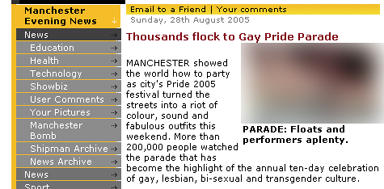On 18 August 2006 I wrote to Manchester Pride with the following questions. I received a reply from Marketing Manchester, saying that I would get a ‘prompt reply’ just as soon as Pride was over. More than two months later I am still waiting…
NOTE: Since I wrote, the page has been edited to remove the 250,000 figure. But I saved a screengrab which you can see here.
Here is my letter:
I notice on the Manchester Pride website you state that the ‘Pride Parade is an ideal opportunity to put your business in front of over 250,000 people’.
Yet on 2 September 2005, the Manchester Evening News wrote: ‘one of the highlights of the (2005) 10-day event was the Key 103 Pride Parade through the streets of Manchester, watched by an estimated 50,000 people.’
I am rather confused. Is it 250,000 or 50,000 people at the parade?
It is interesting to look back at the figures over the years in the Manchester Evening News, because they vary from 385,000 watching the parade in 2001 to just 50,000 last year.
If it was just 50,000 last year, why do you say in your publicity that last year was the ‘best ever’? Particularly as the final sum raised for good causes was the lowest since 2002.
I would also welcome some info about the number of tickets sold.
In the article ‘Fantastic gay pride festival sets record’, published in the Manchester Evening News on 2 September 2005, it states that 2005 was ‘the biggest ever Manchester Pride Festival’ and:
‘The ‘Big Weekend’ in Manchester’s Gay Village provided a huge boost with ticket sales up by 50 per cent.

If ticket sales were up 50% in 2005, how can the sum for good causes be the lowest since 2002? As the money for good causes comes from ticket sales… Does this mean your costs went up by a large amount? I can see no other possible explanation. What were the costs in 2005?
Still on the subject of the 50% increase in ticket sales. In the same article, Andrew Stokes, Chief Executive of Marketing Manchester and Manchester Pride Chairman is quoted as saying: ‘Manchester Pride 2005 was a tremendous success … Over 40,000 people paid to be part of the celebration’
Yet, eleven months earlier, in the October 2004 issue of outnorthwest magazine, Paul Martin of the Lesbian and Gay Foundation refers to the ‘36,000’ who attended Manchester Pride 2004.

So how is that a 50% increase in ticket sales in 2005? A 50% increase on 36,000 would be 54,000.
Please could you also clear up something else for me regarding the recently-introduced £50 fee to take part in the parade?
Am I right in thinking that an individual who is not part of a group will have to pay £50 + VAT?
On the LGF website, Andrew Stokes is quoted as saying:
‘It is a charge for entry, whether there are 1 or 16 people.’
Yet in his letter in the Manchester Evening News Andrew Stokes wrote:
‘I feel it is important to clarify that the £50 charge applied to non-commercial LGBT and HIV group entries to the parade, it is not a charge that is levied per individual.’
As you can see, much of the information above seems to be completely contradictory. When people are paying to come to an event, or companies are paying to take part or advertise, wouldn’t you agree that it is important to give an honest impression of how big that event really is?
Thank you and I hope to hear from you.
The Manchester Evening News
I have also written to the editor of the Manchester Evening News about the wildy-varying figures that have appeared in articles over the years. He hasn’t replied either. These people really don’t think they should be held accountable for what they write do they?

On 28th August 2005, in the article ‘Thousands flock to Gay Pride Parade’, the Manchester Evening News reported that ‘more than 200,000 people watched the parade’.
However, five days later, in the article ‘Fantastic gay pride festival sets record’, (2 September 2005), the Evening News wrote:
‘One of the highlights of the 10-day event was the Key 103 Pride Parade through the streets of Manchester, watched by an estimated 50,000 people.’

A figure that is one quarter of the number stated on 28th August. The BBC website said 45,000 were expected at events from Friday until Monday.
There are many examples of this over the years, relating to attendance figures and ticket sales, in the Manchester Evening News, on various websites and in other publicity material.
On August 29, 2001 the Manchester Evening News claimed that 385,000 people had watched the Saturday Parade. A ludicrous figure, particularly as Gayfest 2001 was a smaller event. The Evening News claimed that ‘250,000 people attended the 10-day festival’ in 2003.
On August 25, 2006, the Manchester Evening News reported:
‘Early ticket sales suggest about 40,000 people will attend the four-day bank holiday event – smashing last year’s record of 35,000 partygoers.’
So, 35,000 in 2005 was a record number? Yet, a year previously, on 2 September 2005 the Evening News had reported that ticket sales in 2005 were up by 50%. And eleven months before that, Paul Martin (of the Lesbian and Gay Foundation) was quoted in OutNorthWest saying 36,000 people attended in 2004!
The Evening News constantly publishes stories saying that 200,000-250,000 are expected. Yet strangely, since Manchester Pride began selling tickets in 2003, only about 35,000 have been sold each year. As you can’t get into the Gay Village without a ticket, what exactly are these hundreds of thousands of other people doing? Where are they? The answer is, they don’t exist.
I believe the false information originates from the organisers and the Evening News is guilty of not verifying it.
Now one of the reasons that Manchester Pride is giving for income being down in 2006 is because they can find fewer sponsors for the event. Which is hardly surprising if the organisers have been guilty of over-inflating attendance figures by up to 700% in the past?
UPDATE: I wrote to Marketing Manchester again on 25 October 2006 with a copy of their August response and my original letter. On 8 November I received a reply in which they promised to ‘respond immediately’ after a meeting on 20 November. But, guess what? They never did.
I wrote to them again on 2 February 2007, reminding them, and finally I received a reply on 12 March 2007, almost seven months after I first asked them. In the reply they state:
‘there will be a difference in the numbers quoted for the parade because it could mean watched by physically on the day or it could mean seen on the TV or media coverage.’
And:
‘The figures you refer to quoted in the MEN in 2005 are not produced by Manchester Pride and as such we can not comment upon how they were calcuated’
However, on 25 August 2006, in the article ‘We’ll attract record crowds predict Pride festival chiefs,’ The Manchester Evening actually quoted Andy Owen of Manchester Pride. He told them that in 2005 ‘about 250,000 people’ had ‘gathered’ in the city centre to watch the Saturday Parade and that this was a figure that the ‘police estimated’.
People who watch on TV do not ‘gather’ in the city centre. Here was a spokesperson for Manchester Pride actually giving the false information to the Evening News. Not only that but, on 12 February 2007 in an email reply, Greater Manchester Police told me:
‘With regards to the estimated attendance figures we get those direct from the organisers.’
So it seems the bit about the figures being ‘police estimated’ is a lie too.

